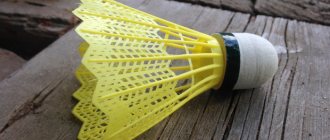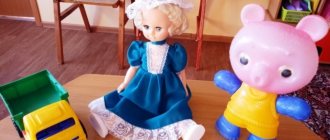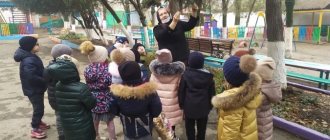long-term planning for the formation of a holistic picture of the world (cognition) of children of the middle group
A long-term plan for the formation of a holistic picture of the world (cognition) of children in the middle group. Developed in accordance with the FGT program for the 2013-2014 academic year. Teacher Musina G. A. September
Week 3 “Hello, kindergarten” Topic: “Kindergarten” Program content: to form ideas about kindergarten employees, about the work processes performed by each of them, to cultivate respect for the work of adults.
For progress, see Z.A. Efanova “Complex Lessons” p. 41 October
1 week “Autumn” Topic “Autumn Weather” Purpose: to teach to observe changes in nature, to describe from a picture;
be able to express your point of view, find differences between autumn and summer. For the move see Z.A. Efanova “Complex classes” p.48 Week 3 “My home, my city” Theme “My city” Goal: to introduce their hometown, its historical past and present, to introduce them to the sights of Kazan, to know the name of the street on which they live, to cultivate love to his native land. Progress see Aji “Notes of integrated classes” page 67 No. 6 November
1 week “Me and my family” Topic “Family” Purpose: to give an idea of what a family is, about family relationships in the family, each of them is simultaneously a son, daughter, granddaughter etc., learn to know and name your closest relatives.
Progress see Volochkova “Lesson notes in middle school.” p.10 Cherenkova “Our Friendly Family” p.153 Week 3 “Man and the Animal World” Theme “Pets” Goal: to concretize ideas about domestic animals, to give an initial idea of their lifestyle and the benefits they bring, to arouse interest in animals, desire take care of them, develop speech and thinking. Progress see Nikolaeva “Young ecologist” p.39 Gorkova “Scenarios for classes in environmental education” p.14 December
1 week “Wild animals” Topic: “Here comes winter” Purpose: to give children ideas about the life of wild animals in winter, to develop interest in the environment nature, cultivate a caring attitude towards animals.
Progress see O.A. Solomennikova page 20 Week 3: “New Year” Topic “Why did the Snow Maiden melt” Goal: expand children’s understanding of the properties of water, snow and ice, teach them to establish basic cause-and-effect relationships: snow melts in warmth and turns into water, In the cold, water freezes and turns into ice. Progress see O.A. Solomennikova p. 24 January
3rd week “Winter” Topic: “Winter” Purpose: to form a general idea of winter and its characteristic signs, to facilitate the independent discovery of these signs (it has become frosty, cold winds are blowing, the reservoir is covered with ice, snowfall) to develop the ability and skills to observe natural objects.
Progress see Gorkov “Scenarios for classes in environmental education” p. 79 February
1 week “I will grow up healthy” Topic “Wonderful doctor” Goal: to give children an idea of the importance of the work of a doctor and a nurse, their caring attitude towards children and people.
Progress see O.V. Dybina p. 24 Week 3 “Defender of the Fatherland Day” Theme “Our Army” Goal: to expand knowledge about the Russian Army, about the soldiers who protect our Motherland, to cultivate respect for people in military specialties. Progress see Dybina “Child and the world around us” p. 27 Irbova “Classes on speech development” p. 91 March
1 week “Mom’s Day” Topic: “Caring for mom” Goal: developing a kind, caring attitude towards mom, the desire to help her, teach her to describe mom.
Progress see Efanova “Complex Lessons” p. 231 Week 3 “Man and the world of things” Topic “Dangers around us” Purpose: to give basic ideas about safety rules in everyday life, about handling matches, knives, hot objects; encourage drawing conclusions based on the proposed problem situations. Progress see Volochkova “Complex classes in the Middle Ages.” page 178 No. 2, page 186 No. 4 April
1st week “Spring” Topic “Insects” Goal: to promote the formation of general ideas about insects, the development of cognitive interest in nature, to be able to see and enjoy the beauty of everything living on earth, to teach to take care of insects, to protect their.
Progress see Gorbatenko “System of environmental education in preschool educational institutions” p. 39 No. 3 Week 3 “Folk culture and traditions” Theme “Earth Festival” Goal: to continue to introduce the concept - the Earth, our common home; introduce environmental protection; cultivate a caring attitude towards the nature of the native land; compose a story about the feasible assistance of each person in preserving the flora and fauna on earth. Progress see Efanova “Complex Lessons” p. 345 May
1 week “Victory Day” Theme “Victory Day” Purpose: to give ideas about the Victory Day holiday, teach storytelling, answer questions, cultivate interest in historical events related to the native country. Progress see Efanova “Complex classes” p. 283 Week 3 “Summer is coming” Topic “Visiting Mishutka” Purpose: to clarify ideas about honey, its beneficial properties, to introduce honey-bearing plants, to develop speech, to arouse interest in nature (flowering plants, insects) to form a caring attitude towards all living things. Progress see “Child in kindergarten” No. 4 2011. p.62
Summary of educational activities on cognitive development in the middle group “Animal World”
Summary of educational activities in kindergarten on cognition. Middle preschool age. Topic: Animals.
Author: Yulia Aleksandrovna Razgulyaeva, teacher at the Municipal Budgetary Educational Institution “Kindergarten No. 25” in Kostroma.
Description of the material: I offer you a summary of direct educational activities for children of the middle group (4-5 years old) on the topic “Animal World”. This material will be useful for middle school teachers. This is a summary of an educational lesson aimed at cultivating interest in the animal world. Summary of direct educational activities of children in the middle group on the topic “Animal World.” Integration of educational areas “Cognition”, “Reading fiction”. Goal : Enriching children's ideas about wild animals, their way of life, housing and nutrition. Objectives: Educational:
1. Formation of a child’s understanding of wild animals, their way of life, housing and nutrition.
2. Activate and expand your vocabulary. 3. Learn to combine speech with movements. Developmental:
1. Develop attention, memory 2. Develop visual perception 3. Develop mental memory
Educational:
1. Cultivate interest in the life of wild animals, a good attitude.
Methods and techniques: visual, didactic game, verbal questions for children. Materials and equipment: toy – bunny; images: bear, fox, wolf, squirrel, hedgehog; cubes for hummocks, pictures of forests; image: carrots, cabbage, nuts, mushrooms, apples, honey, berries, mice, bunnies, chickens. Preliminary work .
Conversations “Who are wild animals?”; Reading stories about animals: “Wolf” by E. Charushin, “Hare’s Paws” - K. Paustovsky. Progress of the lesson:
I am very glad to see you all today.
Today we have a guest. And who is it? We will find out after you solve the riddle. Long ears, called a scythe Very afraid of being caught by a fox Jumps, zigzags, but this is not a dance So he runs away from predators..... (hare) That's right, guys, a bunny came to visit us. Guys, the bunny is in trouble!!! Let's hear what happened. “Guys, urgently help us. A wizard scared us. He bewitched us all. We have forgotten who we are. What should we drink and what should we eat? Help us out, help us And reconcile us urgently” (animals) Guys, you and I need to help the inhabitants of the forest. Shall we help? -Yes! Then we need to rush into the forest to help them. Let's go for a walk in the forest, (children march)
We'll walk merrily.
Let’s walk along the little path (they walk like a “snake” between the hummocks),
one after another in single file, we stood on our toes
(they run on their toes)
and ran to the forest.
We raise our legs higher, (they walk with high steps)
We step on hummocks We step on hummocks We walk very happily
(the children are marching.)
- So you and I came to the forest.
Who lives in the forest? – Animals -What are the names of the animals that live in the forest? – Wild And what wild animals live in the forest, we now find out with the help of riddles.
1. Fluffy little animal jumps and jumps through the trees.
Everyone is quicker and faster. (squirrel) 2. She is more cunning than all the animals, She wears a red fur coat, A fluffy tail is her beauty And her name is .... (fox) 3. All the time he prowls through the forest. He is looking for someone in the bushes. He snaps his teeth from the bushes, Who says this... (wolf) 4. The beast waddles along raspberries and honey. He loves sweets very much. He climbs the hole until spring, where he sleeps and dreams. (bear) 5. He walks in the forest without a bag. He finds apples and mushrooms. There are needles on his back. Who is that at the Christmas tree? (Hedgehog) And now, guys, the bunny and I want to find out where wild animals live and what they eat? Didactic game. “Who lives where and what does he eat?” The Fox lives in ..... hole, the Bear lives in .... den, The wolf lives in... a den, The squirrel lives in... a hollow , And the hedgehog lives... in a hole. The squirrel eats nuts and mushrooms. The hedgehog eats mushrooms and apples . The bear - honey, berries The wolf catches mice, The fox hunts for mice, hares and chickens. - and what do I eat, a bunny? - carrots, cabbage. Physical education
The hares got up early in the morning (walking in place) and played merrily in the forest.
Jump-jump-jump along the paths! (jumping in place)
Who is not used to exercise?
Here is a fox walking through the forest (imitate the movements of a fox)
Who is jumping there? I wonder?
(shrug)
To answer the question,
(turns head left and right)
The little fox pulls his nose
(hands on his belt)
But the little hares jump quickly
(jumping in place)
How could it be otherwise?
(jerks with arms in front of chest)
Training helps.
And the bunnies run away. (running in place)
Here is a hungry fox
(raise his head, look up)
Looks sadly at the heavens
(stretching his arms up)
Sighs heavily,
(deep inhalation and exhalation)
Sits down, rests
(squat down.)
Children, the Bunny is turning to you with the request.
He has the beginning of a sentence, he needs to finish the sentence. Didactic game "Finish the sentence." The hare is white in winter, and gray in summer.
The hare has a short tail, and the ears long . The hedgehog is small, and the bear is large. The gray in winter, and red in summer squirrel has a long tail, and the hare has short tail. The squirrel lives in hollow, and the fox is in (the hole) The fox is cunning, and the hare (cowardly) The hare is fluffy, and the hedgehog is (prickly) Well done, guys, you helped the bunny and coped with the task. The bunny liked how you worked, you told a lot of interesting things about them. They broke the spell. He says thank you. And now it’s time for him to go home to his hole. And it’s time for you and me to return to kindergarten. Let's go home to kindergarten, (Children are marching). Let's walk happily.
Let's walk along the path (They walk like a "snake" between
each other in single file,
"bumps"
. They stood on their toes
(Run on their toes.)
And ran to the kindergarten. We raise our legs higher,
(Walk at a high pace).
We step on the bumps. We step on the bumps We are advancing. We are walking very happily.
(Children are marching)
So our journey into the forest has ended. Did you like it? What did you like most? What wild animals do you remember?
Well done!
We recommend watching:
Summary of directly organized educational activities in the middle group. Educational GCD notes on emotional development in the middle group GCD notes for the middle group. Magic goodness Summary of a lesson on speech development for middle group children with special needs development
Similar articles:
Summary of GCD in the senior group of kindergarten. A dog is man's friend
Summary of the lesson “Exotic animals”. Senior group
About the beaver for children 6-7 years old
A story about a monkey for children 6-7 years old
About possum for children



